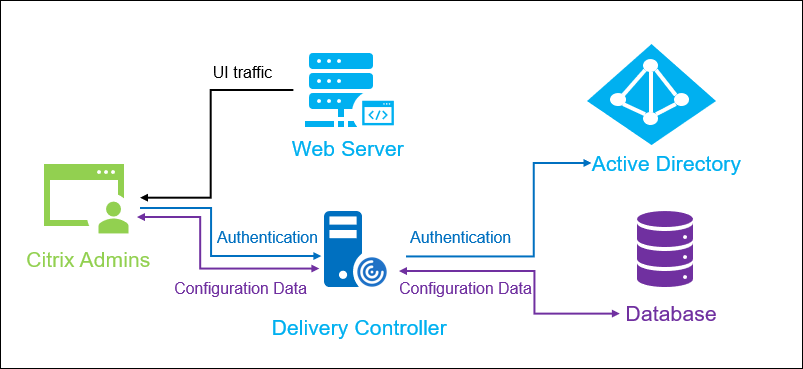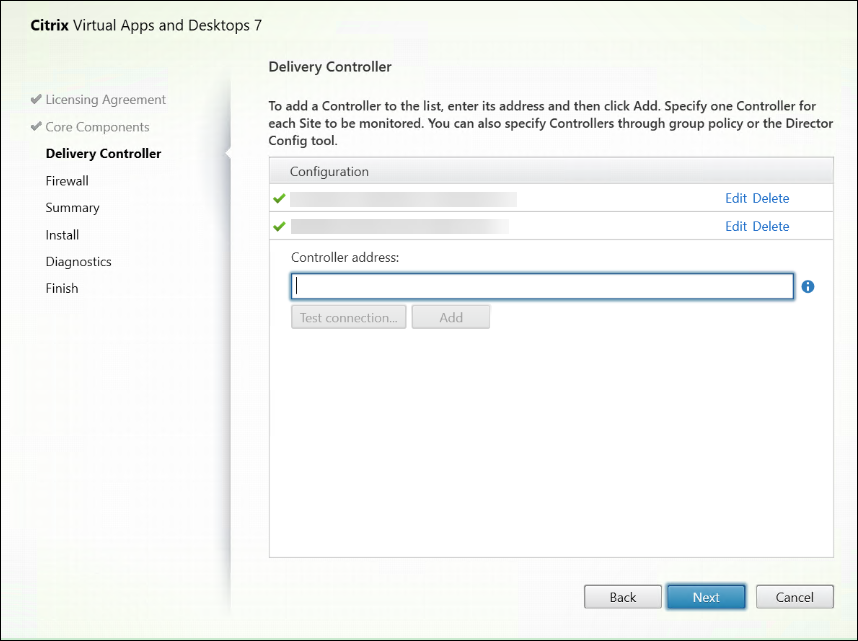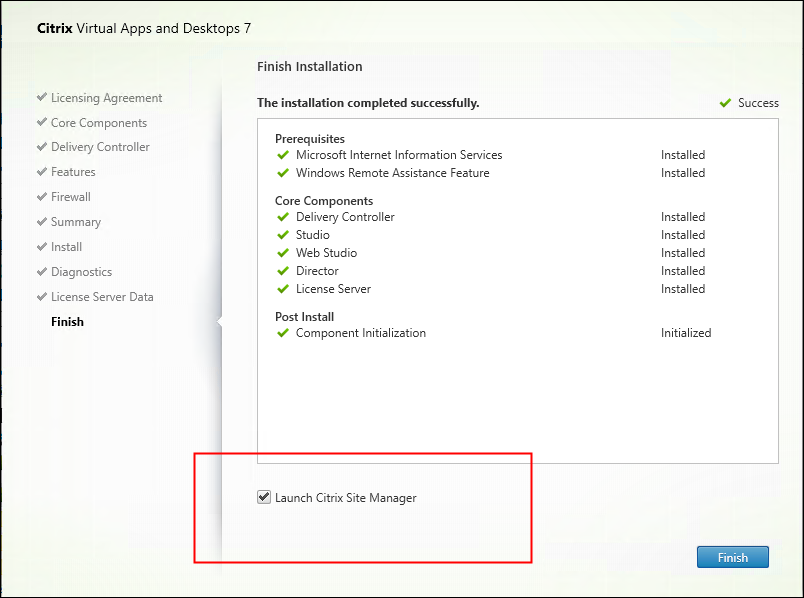Install Web Studio
Introduction
Citrix Studio is a Windows-based management console that lets you configure and manage your Citrix Virtual Apps and Desktops deployment. Web Studio is the next generation of Citrix Studio — a web-based management console offering full feature parity with Citrix Studio. With the same look and feel as the Citrix DaaS Studio interface, Web Studio modernizes your management experience by providing a native web experience.
You can deploy Web Studio to any Windows server with Internet Information Service (IIS) installed. There are two deployment options:
-
Installed on a dedicated server:
For larger environments where performance and scalability are critical, we recommend installing Web Studio on a dedicated server. This server can optionally also host the Director.
-
Integrated with a Delivery Controller™:
For quick deployments and simpler environments, install Web Studio directly on a Delivery Controller. This approach is ideal for smaller deployments where minimizing administrative overhead is a priority.
The following diagram shows the Web Studio architecture:

A general workflow to get Web Studio up and running is as follows:
To set up a load-balanced Web Studio deployment, see this article.
New features available in Web Studio
See the What’s new article.
System requirements
Supported operating systems:
-
Windows Server 2022
-
Windows Server 2019, Standard and Datacenter Editions, and with the Server Core option
-
Windows Server 2016, Standard and Datacenter Editions, and with the Server Core option
Supported browsers:
- Microsoft Edge 92
- Firefox ESR (Extended Support Release) 90
- Google Chrome 92
- Safari 14
The recommended optimal screen resolution for viewing Web Studio is 1440 x 1024.
Prerequisites
This release of Web Studio is compatible with Citrix Virtual Apps and Desktops™ 2212 deployments and later.
For deployments earlier than 2212, first upgrade to 2212 and then install Web Studio.
Known limitations
If you use Web Studio and Citrix Studio interchangeably, consider the following limitation: A template created in Web Studio is not shown in Citrix Studio, and vice versa. This is because Web Studio uses a database different from Citrix Studio to store templates. As a workaround, create a policy from a template in Web Studio and then create a template from this policy in Citrix Studio, and vice versa.
- To ensure a successful installation of Web Studio, do not change the default site name (Default Web Site) in Internet Information Services (IIS) Manager. Any changes to the default site name result in installation failures.
Install Web Studio
The following information is a supplement to the guidance in Install core components. To install Web Studio:
-
Install Web Studio using the full product ISO installer for Citrix Virtual Apps and Desktops. The ISO installer checks for prerequisites, installs any missing components, sets up the Web Studio website (on the Delivery Controller if included in Delivery Controller installation), and performs basic configuration.
-
If Web Studio was not included during installation, use the installer to add Web Studio.
-
When installing Web Studio, you are prompted to type the address of a Delivery Controller.
Note:
- You can add more than one Delivery Controller. Web Studio attempts to connect to them in random order. If the Delivery Controller to which Web Studio is attempting to connect is unreachable, Web Studio automatically falls back to other Delivery Controllers.
- If Director was selected in Core Components and installed, the Delivery Controllers you add here are used for both Web Studio and Director.
- If you don’t have the external public trust certificate configured and don’t want to request the certificate from an enterprise CA, you just need to configure the FQDN of your Delivery Controller.
- If you have the external public trust certificate and can configure the public DNS for your Delivery Controller, you can type the DNS name as the Delivery Controller address.
- If you can request the certificate from your enterprise CA and can specify your personal DNS, you can add your personal DNS as the Delivery Controller address.

-
To secure the communications between the browser and the web server and between the browser and the Delivery Controller, TLS encryption must be enabled on the IIS website hosting Web Studio and on the Delivery Controller. If no TLS certificate is configured for the Delivery Controller, the installer creates a self-signed certificate, with the FQDN of the Delivery Controller and localhost as the DNS name certificate. If a TLS certificate is configured, the installer doesn’t make any change. For more information about TLS encryption, see Secure a Web Studio deployment (optional).
-
On the Finish page, the Launch Site Manager check box is selected by default so that the Citrix Site Manager opens automatically. To launch it later, open your desktop Start menu and select Citrix > Citrix Site Manager. Before you launch Web Studio, you need to use the Citrix Site Manager to create a site or join an existing site. For more information, see Set up a site.

Note:
You can also use the command line to install Web Studio. Example:
.\XenDesktopServerSetup.exe /components webstudio /controllers "ddc1.studio.local" /configure_firewall /quiet. For more information, see Install using the command line.
Set up a site
To set up your Citrix Virtual Apps and Desktops deployment (also known as a site), use the tool, Citrix Site Manager. The tool is installed automatically with a Delivery Controller.
To set up a site, follow these steps:
-
On a Delivery Controller, open the desktop Start menu, and then select Citrix > Citrix Site Manager.
-
In the Citrix Site Manager, select Create a site. The Site Setup wizard appears.
-
Create a site and configure its settings as follows:
- On the Introduction page, type a name for the site.
- The Databases page contains selections for setting up the site, monitoring, and configuration logging databases. For more information, see Step 3. Databases.
- On the Licensing page, specify the License Server address and then indicate which license to use (install). For more information, see Step 4. Licensing.
-
On the Summary page, check all settings and click Submit.
The IP address of this Controller is automatically added to the site.
Note:
The user who creates a site becomes a full administrator for it. For more information, see Delegated administration.
If you install a new Controller after creating a site, you must add the Controller to the site. Detailed steps are as follows:
- Run Citrix Site Manager on this new Controller.
- Select Join an existing site.
- Type the address of a Controller that is already added to the site.
- Click Submit.
Add Delivery Controllers to Web Studio for management
Use the Studio configuration tool to add the Delivery Controllers to Web Studio for management. This tool is available in the Web Studio installation folder.
By default, the tool is installed in the following default folder.
C:\Program Files\Citrix\Web Studio\Tool\StudioConfig.exe
Suppose you want to configure the following two Delivery Controllers for the site that you want to manage with Web Studio: ddc1.studio.local and ddc2.studio.local. Run the following PowerShell command:
.\StudioConfig.exe --server "ddc1.studio.local,ddc2.studio.local"
Note:
- The tool requires computer administrator permissions.
- The Delivery Controller configuration changes might not take effect immediately due to cache settings on the IIS server. For immediate effect, go to the Web Studio server, open Internet Information Services (IIS) Manager, navigate to Start Page > Sites > Default Web Site, and select Restart in the Manage Website pane.
- To view all supported parameters, run
StudioConfig.exe --help.
Configure Web Studio as a proxy for Delivery Controllers (optional)
By default, when you manage your deployment using the Web Studio console, you connect to both the Web Studio server and the Delivery Controllers through the web browser. We provide you with an option to configure the Web Studio server as a proxy for Delivery Controllers. As a result, you connect only to the Web Studio server when managing your deployment.
This section guides you to configure a Web Studio server as a proxy for Delivery Controllers. We assume that Web Studio and Delivery Controllers are installed on different servers.
Before you start, verify that you have all necessary core components installed in your deployment. For more information, see Install core components.
To enable proxy mode for Web Studio, follow these steps:
- On the Web Studio server, run Windows PowerShell as an administrator.
-
Run the following command where you replace
fqdn_of_webstudio_machinewith the FQDN of your Web Studio server.& "c:\Program Files\Citrix\Web Studio\Tool\StudioConfig.exe" --enableproxy --proxyserver "fqdn_of_webstudio_machine"Note:
If you have a load-balanced Web Studio deployment, replace
fqdn_of_webstudio_machinewith the FQDN of the load balancer server (also known as the virtual server). For more information, see Set up a load-balanced Web Studio deployment.
To disable proxy mode for Web Studio, run this PowerShell command:
`& "c:\Program Files\Citrix\Web Studio\Tool\StudioConfig.exe" --disableproxy`
Note:
As a best practice, we recommend that you secure your Web Studio deployment by using an external public trust certificate or a certificate from an enterprise Certificate Authority (CA). For more information, see Secure a Web Studio deployment.
Log on to Web Studio
The Web Studio website is located at https://<address of the server hosting Web Studio>/Citrix/Studio.
To log on to Web Studio, open your desktop Start menu and select Citrix > Citrix Web Studio™. Administrators with permissions for Web Studio must be Active Directory domain users. When logging on to Web Studio, consider the following scenarios:
-
If you have not yet specified Delivery Controllers for the site. You are prompted to specify a Delivery Controller so that you are provided with temporary access to Web Studio.
-
If the specified Delivery Controllers are currently unreachable, you can’t log on to Web Studio. Test your connections to make sure that those Delivery Controllers are reachable. Or specify an alternate Delivery Controller so that you are provided with temporary access to Web Studio.
Next steps
-
Use Web Studio to deliver virtual apps and desktops to your users by: